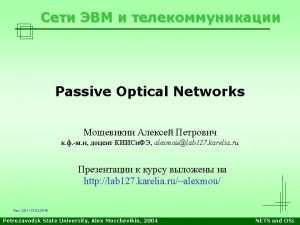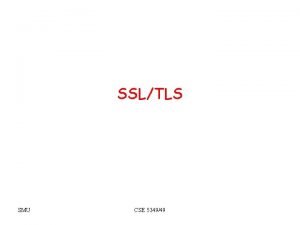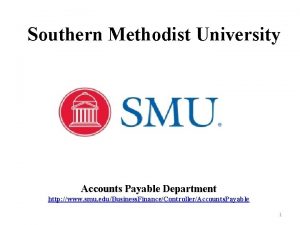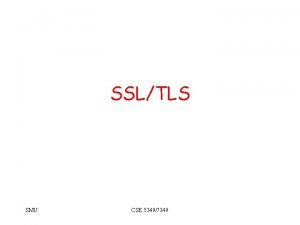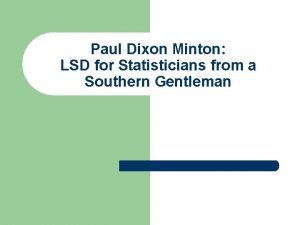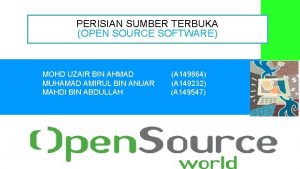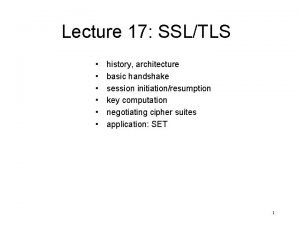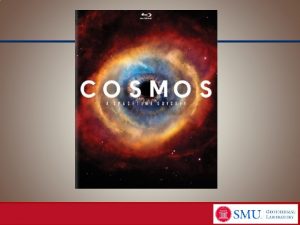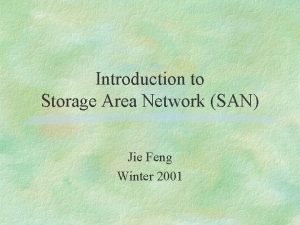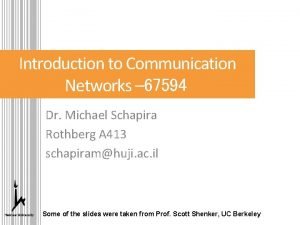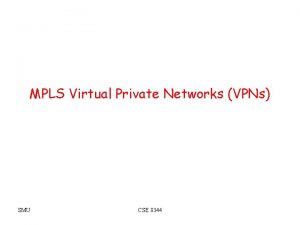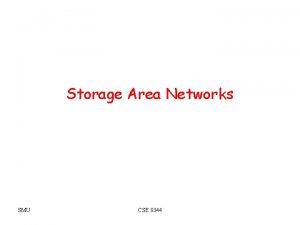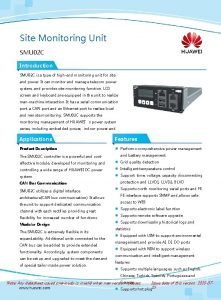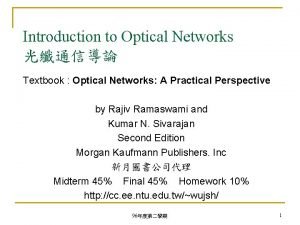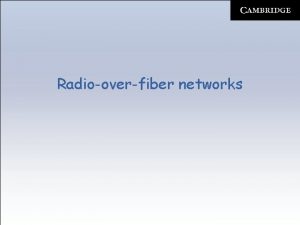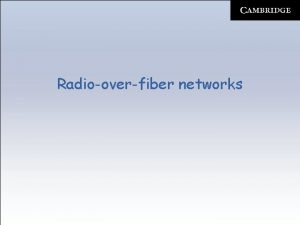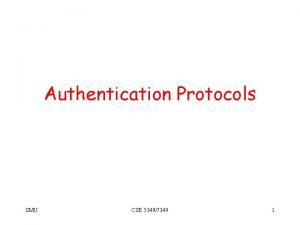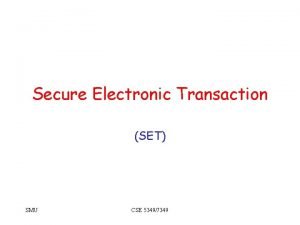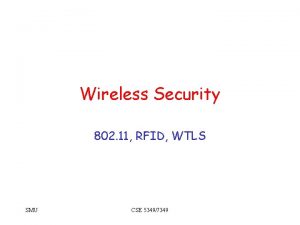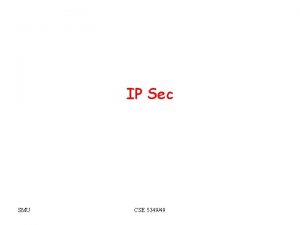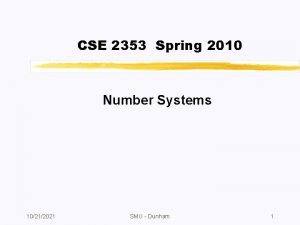Optical Networks Introduction SMU CSE 8344 Why Optical






























- Slides: 30

Optical Networks Introduction SMU CSE 8344

Why Optical? • Bandwidth • Low cost ($0. 30/yard) • Extremely low error rate (10 -12 vs. 10 -6 for copper • Low signal attenuation • Low power requirement • More secure SMU CSE 8344

History – 1 st Generation: Copper is transmission medium – 2 nd Generation: Optical Fiber (late 80 s) • Higher data rates; longer link lengths – Dense Wavelength-Division Multiplexing (DWDM, 1994) • Fiber exhaust forces DWDM • Erbium-doped fiber amplifiers (EDFAs) lower DWDM transmission cost – 3 rd Generation: Intelligent optical networking (1999) • Routing and signaling for optical paths SMU CSE 8344

Medium Characteristics • Attenuation: – Wavelength dependent – 0. 85, 1. 3, 1. 55 micron windows – Attenuation caused by impurities as well as scattering • Dispersion – Inter-modal – Chromatic SMU CSE 8344

Wavelength Division Multiplexing (WDM) • All the bandwidth could not be used due to the electronic bottleneck • Two breakthroughs – WDM – Erbium-doped fiber amplifier (EDFA) • WDM vs. FDM – WDM is passive and hence reliable – WDM carrier frequency orders of magnitude higher SMU CSE 8344

Wavelength Division Multiplexing (WDM) Frequency-registered transmitters l 1 Receivers R All-Optical Amplification Of Multi-Wavelength Signal!!! R l 2 WDM Mux l 3 OA OA WDM De. Mux R 40 - 120 km (80 km typically) l. N Up to 10, 000 km (600 km in 2001 basic commercial products) SMU CSE 8344 R

Regenerators • 3 R – Reshaping – Re-clocking – Amplification • 2 R – Reshaping – Amplification • 1 R (Example – EDFA) – Amplification SMU CSE 8344

DWDM Evolution – Faster (higher speed per wave), • 40 Gb/s on the horizon – Thicker (more waves), • 160 waves possible today – Longer (link lengths before regeneration) • A few thousand km possible today – 160 waves at 10 Gb/s = 1. 6 Tb/s • 25 million simultaneous phone calls • 5 million books per minute SMU CSE 8344

WADMs & WXC • WADM (Wave Add-Drop Mux) – Evolution from p-t-p – Can add and drop traffic at various locations • WXC (Wave crossconnect) – Similar to ADM except that multiple fibers on the input side with the capability to switch colors between fibers SMU CSE 8344

Enabling Technologies • • Fiber and laser technology EDFA MEMS (Micro-Electro Mechanical Systems) Opaque vs. all-optical networks SMU CSE 8344

Current Protocol Stack IP ATM SONET WDM SMU CSE 8344

How Did We Get Here? • SONET over WDM – Conventional WDM deployment is using SONET as standard interface to higher layers • IP over ATM – IP packets need to be mapped into ATM cells before transporting over WDM using SONET frame • OEO conversions at every node is easier to build than all optical switch SMU CSE 8344

Problems with Multilayer • Inefficient – In IP over ATM over SONET over WDM network, 22% bandwidth used for protocol overhead • Layers often do not work in concert – Every layer now runs at its own speed. So, low speed devices cannot fill the wavelength bandwidth. – Under failure, different layers compete for protection SMU CSE 8344

The Roadmap SMU CSE 8344

WDM Network Architecture SMU CSE 8344

Classes of WDM Networks • Broadcast-and-select • Wavelength routed • Linear lightwave SMU CSE 8344

Broadcast-and-Select Passive Coupler SMU CSE 8344 w 0 w 1

Wavelength Routed • An OXC is placed at each node • End users communicate with one another through lightpaths, which may contain several fiber links and wavelengths • Two lightpaths are not allowed to have the same wavelength on the same link. SMU CSE 8344

WRN (cont’d) • Wavelength converter can be used to convert a wavelength to another at OXC • Wavelength-convertible network. – Wavelength converters configured in the network – A lightpath can occupy different wavelengths • Wavelength-continuous network – A lightpath must occupy the same wavelength SMU CSE 8344

A WR Network H I OXC G J F B A K 1 3 SONET 1 2 IP SMU 1 IP E 2 1 D O C N L M SONET CSE 8344

Linear Lightwave Networks • Granularity of switching in wave bands • Complexity reduction in switches • Inseparability – Channels belonging to the same waveband when combined on a single fiber cannot be separated within the network SMU CSE 8344

Routing and Wavelength Assignment (RWA) • To establish a lightpath, need to determine: – A route – Corresponding wavelengths on the route • RWA problem can be divided into two subproblems: – Routing – Wavelength assignment • Static vs. dynamic lightpath establishment SMU CSE 8344

Static Lightpath Establishment (SLE) • Suitable for static traffic • Traffic matrix and network topology are known in advance • Objective is to minimize the network capacity needed for the traffic when setting up the network • Compute a route and assign wavelengths for each connection in an off-line manner SMU CSE 8344

Dynamic Lightpath Establishment (DLE) • Suitable for dynamic traffic • Traffic matrix is not known in advance while network topology is known • Objective is to maximize the network capacity at any time when a connection request arrives at the network SMU CSE 8344

Routing • Fixed routing: predefine a route for each lightpath connection • Alternative routing: predefine several routes for each lightpath connection and choose one of them • Exhaust routing: use all the possible paths SMU CSE 8344

Wavelength Assignment • For the network with wavelength conversion capability, wavelength assignment is trivial • For the network with wavelength continuity constraint, use heuristics SMU CSE 8344

Wavelength Assignment under Wavelength Continuity Constraint • • • First-Fit (FF) Least-Used (LU) Most-Used (MU) Max_Sum (MS) Relative Capacity Loss (RCL) SMU CSE 8344

First-Fit • All the wavelength are indexed with consecutive integer numbers • The available wavelength with the lowest index is assigned SMU CSE 8344

Least-Used and Most-Used • Least-Used • Most-Used – Record the usage of each wavelength – Pick up a wavelength, which is least used before, from the available wavelength pool SMU – Record the usage of each wavelength – Pick up a wavelength, which is most used before, from the available wavelength pool CSE 8344

Max-Sum and RCL • Fixed routing • MAX_SUM Chooses the wavelength, such that the decision will minimize the capacity loss or maximize the possibility of future connections. • RCL will choose the wavelength which minimize the relative capacity loss. SMU CSE 8344
 Hey bye bye
Hey bye bye Datagram vs virtual circuit
Datagram vs virtual circuit Basestore iptv
Basestore iptv Lab127.karelia.ru alexmou
Lab127.karelia.ru alexmou Dont ask why why why
Dont ask why why why Key exchange algorithms
Key exchange algorithms Smu accounts payable
Smu accounts payable Dsa major
Dsa major Smu handshake
Smu handshake Paul dixon smu
Paul dixon smu Smu motto
Smu motto Goh jing rong smu
Goh jing rong smu Smu student senate
Smu student senate Smu purchasing
Smu purchasing Perisian smu
Perisian smu Handshake session
Handshake session Smu geothermal
Smu geothermal Actuarial science smu
Actuarial science smu Smu notebook tender
Smu notebook tender Introduction to storage area networks
Introduction to storage area networks Circuit switched wan
Circuit switched wan Newff matlab
Newff matlab Introduction to communication networks
Introduction to communication networks Cnn ppt
Cnn ppt Introduction to wide area networks
Introduction to wide area networks Xooutput
Xooutput Introduction to switched networks
Introduction to switched networks Why-why analysis
Why-why analysis Willie twister
Willie twister Does this table represent a function why or why not
Does this table represent a function why or why not Does this table represent a function why or why not
Does this table represent a function why or why not



